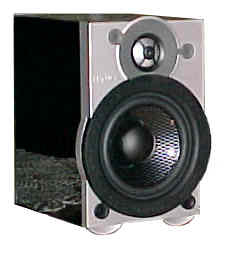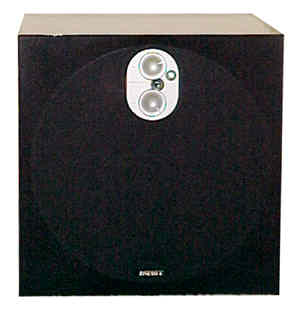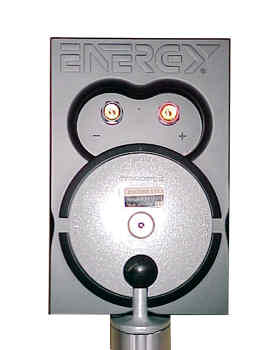Product Review - Energy Encore Home Theater Speaker Package - January, 2001
Vince Hanada
![]()
|
Energy Encore 1 and 2 1" Aluminum Dome tweeter 4" Aluminum polycarbonate woofer (2 in center channel model) MFR: 70 Hz - 22 kHz Encore 8 Powered Subwoofer 8" High-Excursion Polyproplene Woofer, Magnetically Shielded Power: 150 Watt MOSFET MFR: 25 Hz - 100 Hz Package price $1,500 US |
|
Audio Products International, 3641 McNicoll Avenue, Scarborough, Ontario, Canada, M1X 1G5; Phone: 416-321-1800; Fax: 416-321-1500; Web http://www.energy-speakers.com/ |
The Energy Encore is an ambitious follow-up to the company's successful Take 5 system. Consisting of four identical tiny satellite speakers, a matching center channel, and a subwoofer, the Take 5 provided an inexpensive taste of what home theater is all about.
 Energy
seems to have moved the Take 5 concept to the extreme with the Encores,
engineering all new drivers for the suite rather than recycling parts from
other models. Removing the grille cloth from any of the speakers (except the
subwoofer, of course) reveals a high quality 1� aluminum dome tweeter and a
4� diameter woofer (two woofers in the center channel speaker) made of aluminum-polycarbonate
composite. This unusual material
is stiff and lightweight, chosen to result in good transient response with low
coloration. The drivers are
closely spaced together with their rubber surrounds larger than the cabinet
itself. A sealed design, the
cabinet for the main speakers measures a compact 5� x 7-1/2� x 7�.
Energy
seems to have moved the Take 5 concept to the extreme with the Encores,
engineering all new drivers for the suite rather than recycling parts from
other models. Removing the grille cloth from any of the speakers (except the
subwoofer, of course) reveals a high quality 1� aluminum dome tweeter and a
4� diameter woofer (two woofers in the center channel speaker) made of aluminum-polycarbonate
composite. This unusual material
is stiff and lightweight, chosen to result in good transient response with low
coloration. The drivers are
closely spaced together with their rubber surrounds larger than the cabinet
itself. A sealed design, the
cabinet for the main speakers measures a compact 5� x 7-1/2� x 7�.
Around back, there is more good
stuff: 5�way gold-plated binding
posts, and a circular aluminum plate, holding in place a short aluminum
�stand.� This stand allows the speaker to be oriented in many different
ways � on the floor, wall mounting, or even ceiling.
The Encore center channel is compact as well, measuring 15-1/2� x
5� x 7-1/2�. It follows the
usual center channel arrangement of midrange-tweeter-midrange, with ports
flanking each midrange driver. The
tweeter is set higher than the midranges, and all of the drivers are closely
spaced. The Encore speakers are finished in a �burnished ebony
gloss,� resulting in a clean, modern look.
 The
Encore subwoofer sports an 8� high excursion driver, coupled to a 150 Watt
MOSFET amplifier, in a compact 13�x13�x14� enclosure. The
subwoofer controls form a snazzy looking oval on front of the subwoofer.
I wish more subwoofer manufacturers would provide controls this
convenient. The rotary control on
top, labeled �BL,� controls the bass level of the subwoofer relative to
the satellites. The rotary
control on the bottom is labeled �LPF�, and it sets the low pass crossover
point from 50 Hz to 100 Hz. There's
also a toggle switch labeled �A� and �V�.
The �A� position is for listening to audio sources, when
flattest response is desired. The
�V� position (for watching videos) adds a +3 dB boost in the 50 Hz range,
for greater bass impact when watching DVDs.
Because of the front panel control panel, the subwoofer's grille
cannot be removed.
The
Encore subwoofer sports an 8� high excursion driver, coupled to a 150 Watt
MOSFET amplifier, in a compact 13�x13�x14� enclosure. The
subwoofer controls form a snazzy looking oval on front of the subwoofer.
I wish more subwoofer manufacturers would provide controls this
convenient. The rotary control on
top, labeled �BL,� controls the bass level of the subwoofer relative to
the satellites. The rotary
control on the bottom is labeled �LPF�, and it sets the low pass crossover
point from 50 Hz to 100 Hz. There's
also a toggle switch labeled �A� and �V�.
The �A� position is for listening to audio sources, when
flattest response is desired. The
�V� position (for watching videos) adds a +3 dB boost in the 50 Hz range,
for greater bass impact when watching DVDs.
Because of the front panel control panel, the subwoofer's grille
cannot be removed.
Around back,
there are speaker level inputs for connecting the speaker output of your
amplifier,
and speaker level outputs for connecting the satellite front left/right speakers
out of the subwoofer's high pass circuitry. Curiously, these speaker connections seem to be of cheaper
quality compared to the ones supplied on the satellites.
There is also an RCA input for connecting the subwoofer to the
line-level subwoofer output of a receiver, and a second RCA input for connecting the sub using the sub's
internal crossover. The sub has a
large diameter port in the back, and is furnished in the same ebony gloss as
the speakers.
Our
review set shipped with a pair of optional aluminum stands.
The columns of these stands have an airfoil profile, and the speaker
base screws directly onto the stands. They
can be filled with sand to reduce vibration, an exercise I chose to forgo.
The
Encore system (except for the stands) is shipped in one compact, 75-pound box.
Energy makes it very easy for the consumer to set up the system, even
supplying the tools for putting the stands together.
The system was a breeze to assemble, except for those stands.
The aluminum base of the speaker, and the heavy-duty metal base of the
stand both connect to the column using tapping wood screws.
I had to fiddle around with the screws to get them to bite into the
aluminum. Once screwed into
place, however, the stands were quite sturdy.
 The
Energy Encores exude style and class. The
gloss finish, the silver speaker baffle, and the matching stands would look
great in any contemporary living room, and match particularly well with
one of those new silver, flat screen TVs.
Their compact dimensions allow easy and optimal placement in any room
where space is at a premium. Because
they do not dominate a room, this system is one of the most spouse-friendly
systems around. However, enough
about the looks � the real question is how does the Energy Encore Home
Theater System perform?
The
Energy Encores exude style and class. The
gloss finish, the silver speaker baffle, and the matching stands would look
great in any contemporary living room, and match particularly well with
one of those new silver, flat screen TVs.
Their compact dimensions allow easy and optimal placement in any room
where space is at a premium. Because
they do not dominate a room, this system is one of the most spouse-friendly
systems around. However, enough
about the looks � the real question is how does the Energy Encore Home
Theater System perform?
I tried the Encore system in a variety of configurations, from the ubiquitous 5.1 home theater application, to a layout using only the two mains and sub in a two-channel music system. By using the system in various scenarios, I strove to determine the full potential of the Encores.
I initially connected the speakers to my home theater system. I moved the subwoofer around, and I found the best location in the front of the room, adjacent to the television. The main satellites were slightly toed in towards the sofa, and the surround satellites were arranged slightly behind the sofa, about 2 feet higher than ear level and firing diagonally across the room. The center channel was placed on top of my 32� screen. I set my processor for all speakers to �small� and the subwoofer to �ON�. I used the line-level subwoofer output from the receiver to the subwoofer, and the satellites were connected directly to the speaker terminals on the receiver.
My first impression was one of disappointment. The whole system had a budget sound to it � the front soundstage was closed in. The mains sounded thin, and strained. The subwoofer was boomy. However, the dialog from the center channel sounded clear. Playing around with my processor menu, I tried setting the speakers in the �large� position. This setting slightly improved male voices from the center channel, but I wasn't completely satisfied with the overall sound. I must say that this isn't completely the fault of the speakers � my processor may have its internal crossovers set too high, or it may not be redirecting the bass properly to the subwoofer.
Next, I ran my left and right speaker connections from my home theater amps to the inputs of the sub, and connected the front satellites to the output of the sub. I then changed the settings on my processor, redirecting all of the bass to the main speakers. Running test tones with a Radio Shack sound level meter to facilitate setting the subwoofer/main satellite blend, I was able to obtain the smoothest balance when setting the low pass crossover at the extreme clockwise setting, or approximately 100 Hz, delivering pleasing bass response down to 35 Hz. These settings worked for my room, but your experiences may vary.
With this configuration, the sound of the Energy Encores was transformed. I was now very impressed with the seamless soundstage presented in front, with the center channel matching impeccably to the main satellites. On the DVD, �Seven Years In Tibet,� there are a few scenes of automobiles panning across the screen near the beginning of the movie. The Encores followed the action perfectly. With the subwoofer in place, the thin, strained lower midrange was not evident. This was replaced with a robust, exciting sound. At loud listening levels, the tweeter is wonderful, never sounding too harsh, strained, or closed in. It is not as airy and extended as the best tweeters around, but this is expected given its reasonable price. So, if you buy the Encores, use them with the speaker-level connections rather than line-level. That is the way the work best.
The Encore surround speakers were obviously a good match for the front speakers, since they are identical. I generally prefer dipoles for surround speakers because of their diffuse sound field, but not all rooms are dipole friendly. The small size of the Encore surrounds makes it easy to try different configurations: For movie soundtracks, I faced the Encores towards the side walls, giving me the diffuse sound that I prefer. For 5.1 channel music from my newly acquired DVD-Audio player, I preferred firing the Encore surrounds into and diagonally across the room. The versatile Encores surround speakers worked quite well in both situations.
 The
speaker that impressed me the most in the Encore system is the center channel.
This speaker rendered all voices cleanly, with no hint of cabinet
coloration that I find in some larger center speakers.
Male voices did not have a chesty sound, and were portrayed very
naturally. Sarah McLachlan singing �When She Loved Me� in �Toy
Story 2� sounded sweet and silky. The
small front baffle and closely spaced drivers act as a virtual point source,
anchoring the dialog to the center of the screen where it should be, no matter
where I sat.
The
speaker that impressed me the most in the Encore system is the center channel.
This speaker rendered all voices cleanly, with no hint of cabinet
coloration that I find in some larger center speakers.
Male voices did not have a chesty sound, and were portrayed very
naturally. Sarah McLachlan singing �When She Loved Me� in �Toy
Story 2� sounded sweet and silky. The
small front baffle and closely spaced drivers act as a virtual point source,
anchoring the dialog to the center of the screen where it should be, no matter
where I sat.
The Encore sub was generally good as well. Its instant �on� feature worked flawlessly, never missing a bass note, and its small size allowed easy placement in various locations in my room. It added impact to the home theater experience, but is not as visceral as larger subs. It was able to fill my medium sized room with solid bass, but could not quite shake the walls. For my listening, I left the �A/V� switch to �A� most of the time, since I found that the �V� setting added too much bloom. Those with smaller rooms (say 1500 ft3 or less) should be pleased with both the bass quality and quantity of the Encore subwoofer.
A solution for more visceral bass is to add another sub. I tried this by adding my usual 12� sub into the system. This took the whole home theater experience with the Encores up another notch, giving the system accurate and decent bass up front, and big bass impact with the my regular sub as the dedicated LFE channel. I really enjoyed the Energy Encore system in this configuration, giving me an involving home theater experience.
I also evaluated the Energy Encores using the fronts and sub as a sub-sat system in a dedicated two-channel music setup. After adjusting the subwoofer's controls to provide a good blend between sub and satellite, I listened to a variety of music, including the Fairfield Four's �Roll Jordan Roll,� where the Encores imaged extremely well. All of the male vocals could be easily picked out in a coherent soundstage. In Holly Cole's �Train Song�, the deep bass notes rendered beautifully, sounding dynamic and tight. Holly Cole's voice was easily discernible in the center of the soundstage. At times, the Encores exhibited thinness in the upper bass and sounded strained at loud listening levels in a larger room. Overall, however, I enjoyed listening to music with the Encores system.
With the Encores, Energy has gone an extra step to engineer a home theater system that is easy to own. Its beautiful styling looks great in most rooms. Its small size and built-in wall brackets allow easy placement. As well, the parts used are very high quality, allowing the owner of the system to add components such as larger subwoofers to take the performance to higher levels. Most importantly, the Energy Encores sounded great for both music and home theater. If your living room is space challenged, I highly recommend that you give the Energy Encores am audition.
- Vince Hanada -
![]()
� Copyright 2001 Secrets of Home Theater & High Fidelity
Return to Table of Contents for this Issue.


